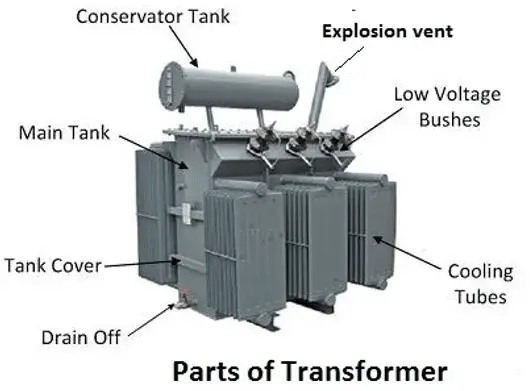A transformer is a static piece of equipment that does not have any moving parts in it. The transformer transforms higher voltage to lower voltage or vice versa without changing the frequency. The input and output power remain the same, ignoring the small losses in the transformer.
The transformer functions on the principle of Faraday’s law of electromagnetic induction. The voltage induced in the primary and secondary winding is directly proportional to the rate of change of flux.
Why Transformer is required?
The power generation plant is usually located near the source of fuel availability point and usually very far from the power utilization ends. The transmission of power at a low voltage level causes voltage drop and line loss. The increased transmission voltage leads to lower losses and good voltage regulation. Therefore, the generation voltage is boosted to high voltage through a step-up transformer at generating station end for transmission purposes. The voltage is stepped up using a step-up transformer.

In a step-up transformer, Vs>Vp and Ns>Np. Examples of the step-up transformer is 11/132 kV,11/220 kV, and 6.6/132 kV transformer.
The voltage at the utilization level is stepped down by the transformer. Thus, the main equipment used for stepping up and stepping down the voltage is a transformer.

In a step-down transformer Vs < Vp and Ns<Np. Examples of step-down transformers are 132/6.6 kV, 132/11kV, 6.6/0.440 kV, 11/6.6 kV,11/3.3kV, etc.
Construction of Transformer

Parts of Transformer
| S.N | Name of Part | Description |
| 1. | Winding | The primary and secondary winding is made of copper. |
| 2. | Conservator Tank | It is used to take care of for expansion and contraction of transformer oil. |
| 3. | Breather with silica gel | It is used to remove the moisture from the air entering the transformer |
| 4. | CRGO Magnetic core | Laminated steel CRGO core is used for providing a low permeability path to flux |
| 5. | Pressure Release device | Used to protect the transformer in the case of a major fault inside the transformer |
| 6. | Buccholtz Relay | Used as protective equipment in the case of a fault in the transformer |
| 7. | Dielectric Materials | The insulating materials used to insulate live parts from nonconducting parts of the transformer |
| 8. | Mineral Oil | Used for insulation and cooling Purpose |
| 9. | On load Tap Changer | Used to increase/decrease the voltage under on condition of the transformer |
| 10. | OFF load Tap Changer | To increase /decrease the voltage under the off condition of the transformer |
| 11. | Bushings ( LV and HV) | Used for Connection for HV and LV side |
| 12. | Radiator or Cooling tubes | Used for cooling of transformer |
| 13. | External Cooling Fans | Used for forced cooling of the radiator tubes |
| 14. | Main Tank | The transformer winding and core are fixed inside the main tank. |
Types of Transformer
Transformers can be classified into different categories on the basis of the following factors.
1. Position of the winding around the magnetic core
- Core Type
- Shell Type
2. According to the turn Ratio or transformation ratio
- Step-up
- step- down
3. Types of service
- Power Transformer
- Distribution Transformer
- Auto Transformer
- Isolation Transformer
- Instrument Transformer
- Potential Transformer
- Current Transformer
4. On the basis of supply
- Single Phase
- Three Phase
5. On the basis of Cooling
- Air Natural (AN) or Self cooled
- Air Force(AF)
- Oil Natural Air Natural(ONAN)
- Oil Natural Air Force (ONAF)
- Oil Force Air Force (OFAF)
- Oil Natural Water Force (ONWF)
- Oil Force Water Force ( OFWF)
EMF Equation of Transformer
The voltage induced in the primary is;

Voltage Induced in the secondary is;

Dividing equation(2 ) by Equation(1)

Losses in Transformer
The following types of losses occur in a transformer.
- Hysteresis loss
- Eddy current loss
2. Copper losses
3. Stray losses
Efficiency of Transformer
The ratio of output power to input power is known as the efficiency of a transformer.
